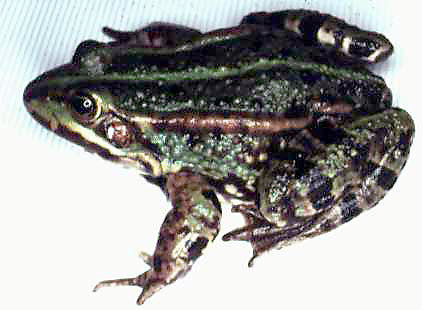
Click on an image to view larger version & data in a new window

Hybridogenetic hybrids
The following hybrids are known to be hybridogenetic
. These hybrids can persist in nature by backcrossing with one of
their parental species. This reproduction mode is not very common and
is known only in fish (Poeciliopsis) in mexican desert streams
and in stick insects ( Bacillus). [
Explanation of this reproduction mode]
These hybrids are very successful and occupy large parts of the distribution
range of their parental host species. In Central Europe Rana lessonae
and the hybridogenetic hybrd Rana esculenta co-occur in almost
every bigger water body in frequencies of the hybrid from 5% in bogs,
20-50% in ponds and small lakes to 95% in disturbed habitat like gravel
pits.
Real hybrids
There are also hybrids which occur naturally, but in low frequencies.
These have mostly a disturbed reproduction or are sterile.
References
Hotz, H. and P. Beerli. Sources of clonal diversity in a system of hemiclonal Rana hybrids. In: Halliday, T., J. Baker and L. Hosie (ed.): First World Congress of Herpetology. Abstracts. University of Kent, Canterbury: [149].
Hotz, H., L. Berger, T. Uzzell, H.G. Tunner, P. Beerli, and G.-D. Guex. Sex determination, sex linkage, and two kinds of unisexuality among XX and XY genotypes in western Palearctic water frogs. In: Catzeflis, F. M. and M. Gautier (ed.). Evolution 93. Fourth Congress of the European Society for Evolutionary Biology. Montpellier, August 22-28, 1993: 181.
Hotz, H., R. D. Semlitsch, S. Schmiedehausen, P. Beerli, and G.-D. Guex. Differential performance of LDH-B genotypes in water frogs. In: Catzeflis, F. M. and M. Gautier (ed.). Evolution 93. Fourth Congress of the European Society for Evolutionary Biology. Montpellier, August 22-28, 1993: 182.
Semlitsch, R. D., S. Schmiedehausen, H. Hotz, P. Beerli, and G.-D. Guex. Differences in larval performance among coexisting hemiclones of hybridogenetic water frogs are of similar magnitude as those between hybrids and parental species. In: Catzeflis, F. M. and M. Gautier (ed.). Evolution 93. Fourth Congress of the European Society for Evolutionary Biology. Montpellier, August 22-28, 1993: 409.
Gutmann S., H. Hotz, E., Semlitsch, R. D., G.-D. Guex, P. Beerli, L. Berger, and T. Uzzell. 1994. Spontaneous heterosis in larval life-history traits of hemiclonal water frog hybrids. II. International symposium of ecology and genetics of European water frogs. September 1994. Wroclaw, Poland.
Hotz H., P. Beerli, G.-D. Guex, R. D. Semlitsch, and T. Uzzell. 1994. Clonal diversity and hybrid frequency are not correlated in water frogs: is the Frozen Niche Variation model wrong? II. International symposium of ecology and genetics of European water frogs. September 1994. Wroclaw, Poland.
Semlitsch, R. D., H. Hotz, G.-D. Guex, and P. Beerli. 1994. Balancing interclonal selection and the maintenance of more than one hemiclone in populations of the hybrid frog Rana esculenta. II International symposium of ecology and genetics of European water frogs. September 1994. Wroclaw, Poland.
About This Page
Peter Beerli

Florida State University, Tallahassee, Florida, USA
Page copyright © 1995 Peter Beerli





 Go to quick links
Go to quick search
Go to navigation for this section of the ToL site
Go to detailed links for the ToL site
Go to quick links
Go to quick search
Go to navigation for this section of the ToL site
Go to detailed links for the ToL site